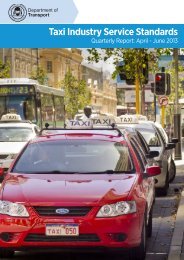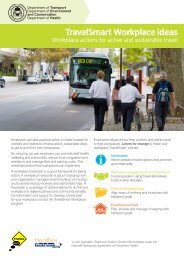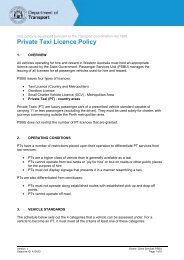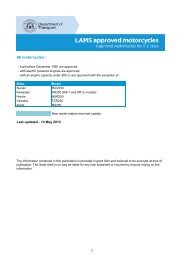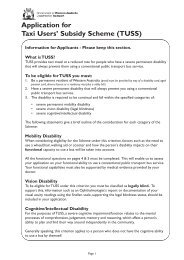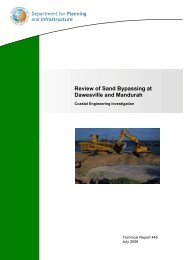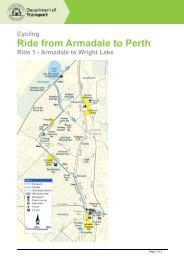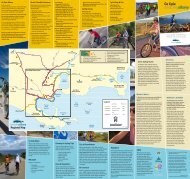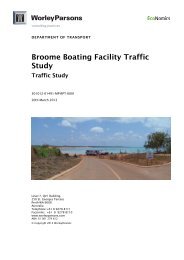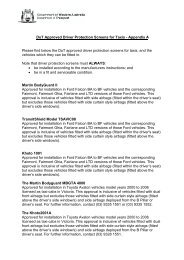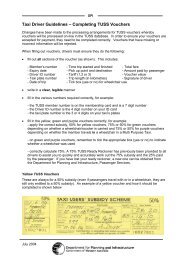Department of Transport Annual Report 2010 - 2011
Department of Transport Annual Report 2010 - 2011
Department of Transport Annual Report 2010 - 2011
Create successful ePaper yourself
Turn your PDF publications into a flip-book with our unique Google optimized e-Paper software.
(f) Property, plant and equipment and infrastructure<br />
Capitalisation/expensing <strong>of</strong> assets<br />
Items <strong>of</strong> property, plant and equipment and infrastructure costing $5,000 or more are<br />
recognised as assets and the cost <strong>of</strong> utilising assets is expensed (depreciated) over their<br />
useful lives. Items <strong>of</strong> property, plant and equipment and infrastructure costing less than<br />
$5,000 are immediately expensed direct to the Statement <strong>of</strong> Comprehensive Income.<br />
Initial recognition and measurement<br />
All items <strong>of</strong> property, plant and equipment and infrastructure are initially recognised<br />
at cost.<br />
For items <strong>of</strong> property, plant and equipment and infrastructure acquired at no cost or for<br />
nominal cost, the cost is their fair value at the date <strong>of</strong> acquisition.<br />
Subsequent measurement<br />
Subsequent to initial recognition as an asset, the revaluation model is used for the<br />
measurement <strong>of</strong> land and buildings, and the cost model for all other property, plant,<br />
equipment and infrastructure. Land and buildings are carried at fair value less<br />
accumulated depreciation (buildings only) and accumulated impairment losses. All<br />
other items <strong>of</strong> property, plant, equipment and infrastructure are stated at historical cost<br />
less accumulated depreciation and accumulated impairment losses.<br />
Where market-based evidence is available, the fair value <strong>of</strong> land and buildings is<br />
determined on the basis <strong>of</strong> current market buying values determined by reference to<br />
recent market transactions.<br />
Where market-based evidence is not available, the fair value <strong>of</strong> land and buildings<br />
is determined on the basis <strong>of</strong> existing use. This normally applies where buildings<br />
are specialised or where land use is restricted. Fair value for existing use assets is<br />
determined by reference to the cost <strong>of</strong> replacing the remaining future economic benefits<br />
embodied in the asset, i.e. the depreciated replacement cost.<br />
When buildings are revalued, the accumulated depreciation is eliminated against the<br />
gross carrying amount <strong>of</strong> the asset and the net amount restated to the revalued amount.<br />
Independent valuations <strong>of</strong> land and buildings are provided annually by the Western<br />
Australian Land Information Authority (Valuation Services) and recognised annually to<br />
ensure that the carrying amount does not differ materially from the asset’s fair value at<br />
the end <strong>of</strong> the reporting period.<br />
The most significant assumptions in estimating fair value are made in assessing whether<br />
to apply the existing use basis to assets and in determining estimated useful life.<br />
Pr<strong>of</strong>essional judgement by the valuer is required where the evidence does not provide a<br />
clear distinction between market type assets and existing use assets.<br />
Refer to note 21 Property, plant, equipment, vehicles and vessels for further information<br />
on revaluations.<br />
Derecognition<br />
Upon disposal or derecognition <strong>of</strong> an item <strong>of</strong> property, plant and equipment, any<br />
revaluation surplus relating to that asset is retained in the asset revaluation surplus.<br />
Asset revaluation surplus<br />
The asset revaluation surplus is used to record increments and decrements on the<br />
revaluation <strong>of</strong> non-current assets as described in note 21 Property, plant, equipment,<br />
vehicles and vessels.<br />
Depreciation<br />
All non-current assets having a limited useful life are systematically depreciated over<br />
their estimated useful lives in a manner that reflects the consumption <strong>of</strong> their future<br />
economic benefits.<br />
Land is not depreciated. Depreciation on other assets is calculated using the straight<br />
line method, using rates which are reviewed annually. Estimated useful lives for each<br />
class <strong>of</strong> depreciable asset are:<br />
Buildings 40 years<br />
Computer hardware 4 to 7 years<br />
Refurbishments, furniture and fittings 3 to 20 years<br />
Maritime infrastructure 5 to 100 years<br />
Plant and equipment 5 to 20 years<br />
Vehicles 5 to 20 years<br />
Vessels 10 years<br />
Leased plant, equipment and vehicles 2 years<br />
Assets under construction are not depreciated until commissioned.<br />
55



